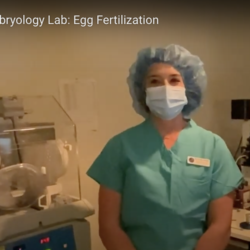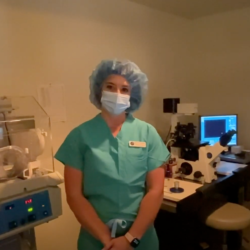
There’s nothing more beautiful than the act of introducing a precious new life into the world, and few things as frustrating as not being able to do so despite your best efforts. Thankfully, science has provided many hopeful parents with the ability to have children through assisted reproductive technology (ART). The most popular and effective form of ART is in vitro fertilization, better known as IVF. One of the largest risks with this approach, however, is IVF twins or multiple births. Here’s what you should know. To schedule an appointment with one of your fertility specialists click here.
What are the chances of twins with IVF?
No medical procedure is without risk. While IVF is certainly among the safest procedures, it is no exception to this rule. One of the most common risks associated with this approach has historically been multiple births. The number of embryos transferred during an IVF cycle directly influences the risk of twins or multiples. In the past, the number of embryos transferred was higher and led to an increase in multiple births.
Natural twin rates are at about 2%. Put simply, twins are rare.
Assisted reproductive technologies changed this. Centers for Disease Control (CDC) research found that of infants conceived with ART:
- 43% were twins
- 3% were triplets or higher-order infants
Put another way, while infertility treatments account for up to 3% of all single live births, they may account for up to 50% of twins born and 75% of higher-order multiple births.
What if we want twins?
But wait, you may be thinking, twins sound great!
Due to a complex set of circumstances—including the cost of IVF in the U.S. and increasing maternal age—transferring multiple embryos during the embryo transfer stage of IVF became desirable. Rather than pay for multiple rounds of IVF, parents could opt to increase their chances during the first try.
And, at first glance, this may make sense. Unfortunately, the risks and cost involved are much higher. While these couples may save money during the initial fertility treatment process, they often end up spending far more money in the long run to support twins, triplets, quadruplets, or more.
Make no mistake about it. Multiples are more expensive, from the costs of their births to feeding, clothing, and otherwise caring for them. That’s even before the inherent risks of carrying IVF twins or multiples.
What are IVF multiple birth risks?
The human womb is made to carry one child to term. Add another fetus or more, and the risks for a preterm birth or other pregnancy complications increase.
IVF multiple births risks include:
- Almost 60% of twins and 90% of triplets are delivered preterm
- Life-threatening maternal complications are two times higher among twin pregnancies
- Maternal death rates are almost four times higher with twins
- Multiple births increase the risk of premature birth and low birth weight
- Other complications like pre-eclampsia or twin-to-twin transfusion syndrome (TTTS) are more prevalent
Preterm births are especially dangerous. They can lead to infant mortality in serious cases or long-term mental and physical disabilities. Beyond initial neonatal care costs, a pre-term infant may also require continued care for learning difficulties, chronic lung conditions, or immune system problems, among others.
Why we focus on single embryo transfers
The risks of IVF twins or multiple births are scary. However, modern fertility clinics are working to reduce these risks.
Limiting the number of embryos transferred during IVF is the single best way to reduce the risk of multiples. At The Fertility Clinic and other leading institutions, single embryo transfers (or SET) are the first choice of care. The CDC, American Society for Reproductive Medicine, and the Society for Assisted Reproductive Technology all recommend a single embryo transfer for the majority of IVF patients.
As we explored in detail in an earlier post, single embryo transfers have similar success rates to multiple transfers for IVF. Ideal candidates for single embryo transfers include those who:
- Are 38 years or younger
- Have good quality eggs and embryos
- Have not yet attempted IVF therapy
If you’re over the age of 38 or have undergone multiple IVF cycles with no success, your doctor may discuss transferring multiple embryos. You can learn more about current recommendations in The American Society for Reproductive Medicine’s embryo transfer guidelines.
Other ways of managing IVF multiple birth risks
Our fertility experts at The Fertility Institute also utilize methods such as blastocyst culture and transfer to improve your chances of a successful pregnancy while reducing the odds of multiples births.
With the blastocyst culture and transfer method, we monitor the growth of embryos for five days instead of three, as with conventional methods. Then, we choose only the healthiest embryos to transfer and limit their number in order to reduce multiple births while increasing your chances of a successful pregnancy.
We also make it a priority to discuss cost up-front to lessen its impact on your decisions. You can learn more about how to manage fertility treatment costs here, figure out if IVF is covered by your insurance provider here, or learn more about our repeat cycle discounts.
If you and your fertility team do decide to transfer multiple embryos, we’ll suggest ways to more closely monitor and manage your pregnancy to reduce risks.
Learn more
At The Fertility Clinic, we serve patients across Louisiana and our neighboring states, and have done so for over 30 years. At our clinic, IVF twins, triplets, and higher order pregnancies do not occur often, but they are a possibility. We work diligently to help you start or expand your family while managing all possible risks. During your initial consultation, we’ll discuss these in detail so you can make the most confident and informed choices about your fertility treatments.
If you would like to learn more about how we approach in vitro fertilization treatments, we invite you to contact The Fertility Institute today. Our team is always here to help guide you in your fertility journey. The current number of pregnancies at the Fertility Institute is 18,791.



